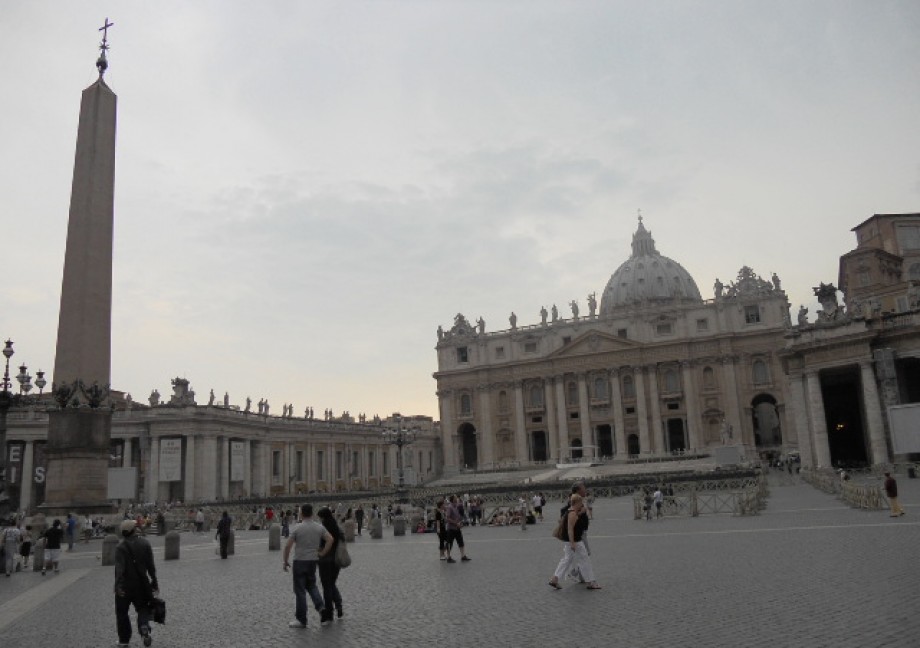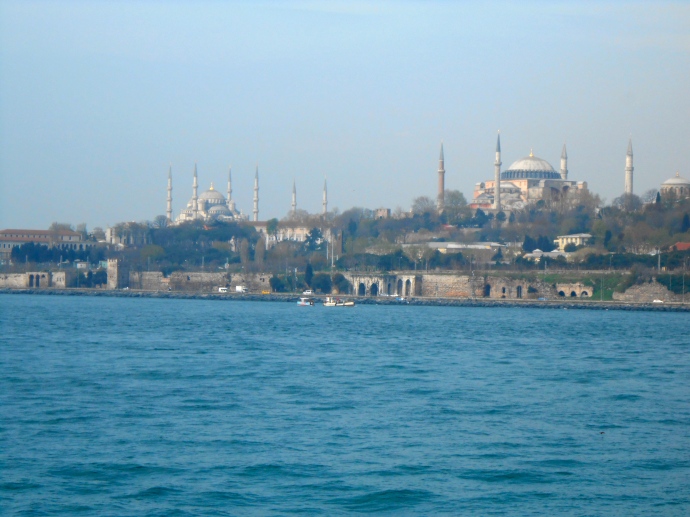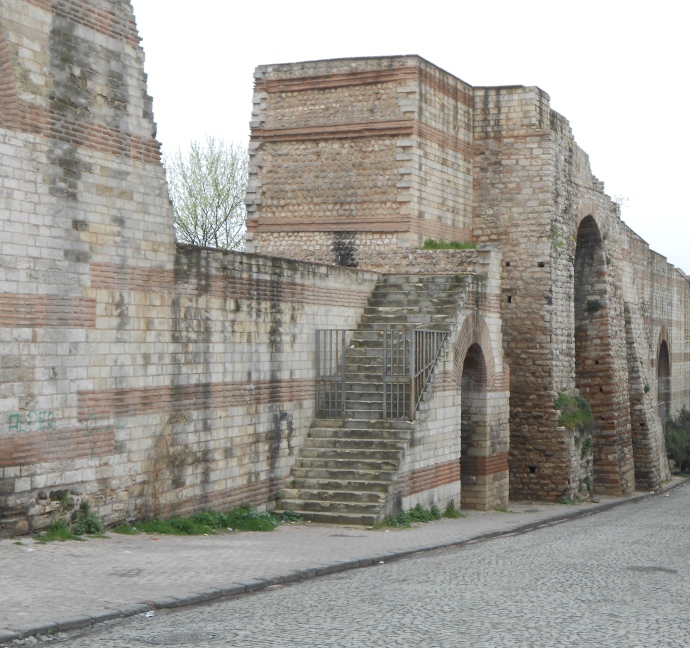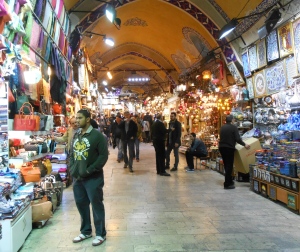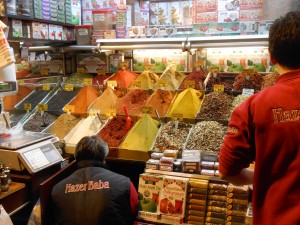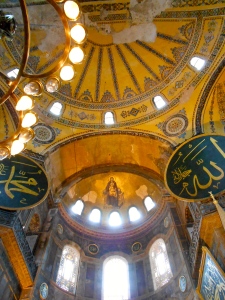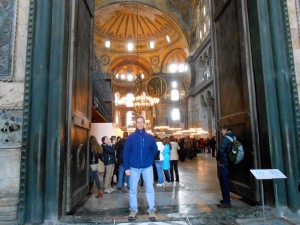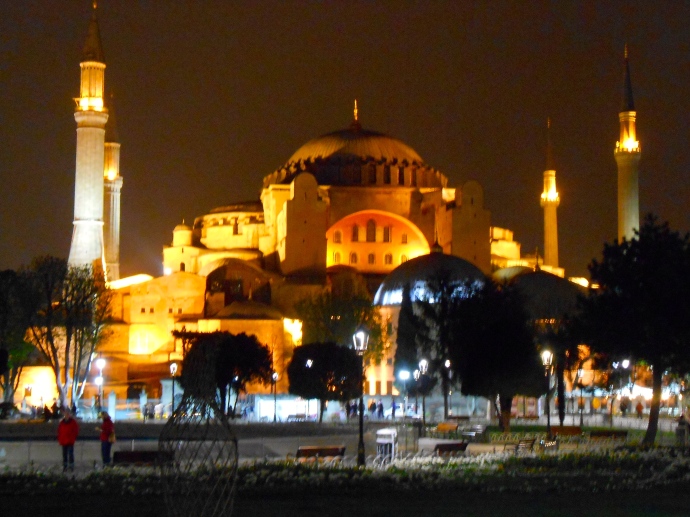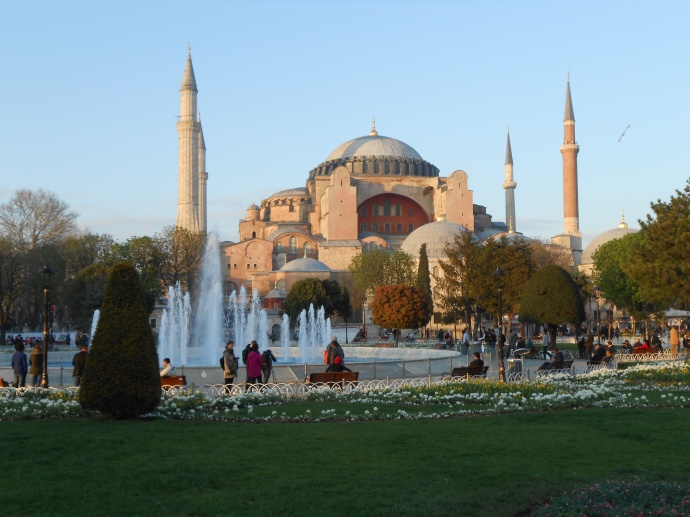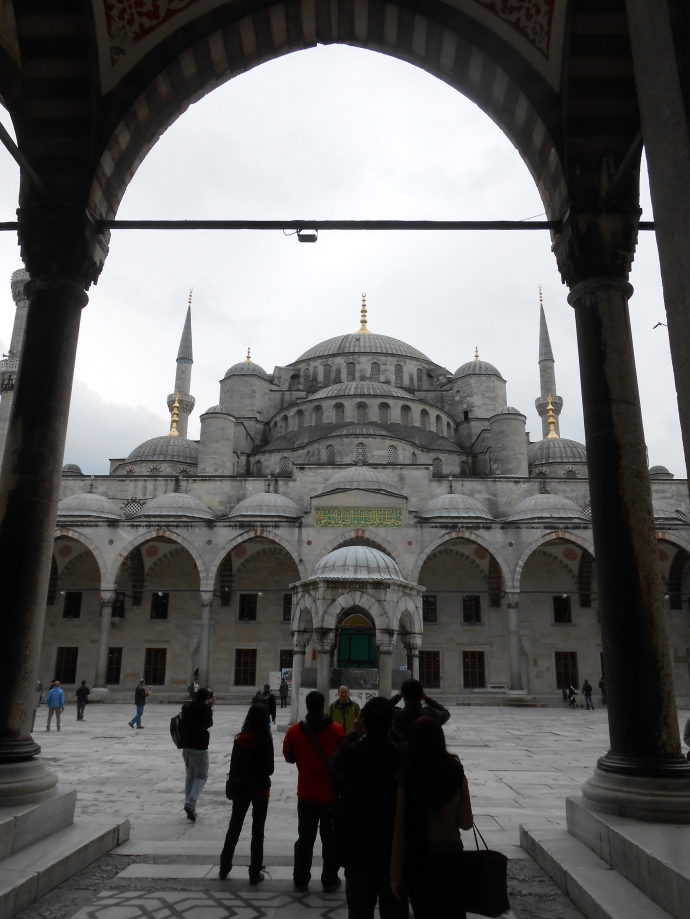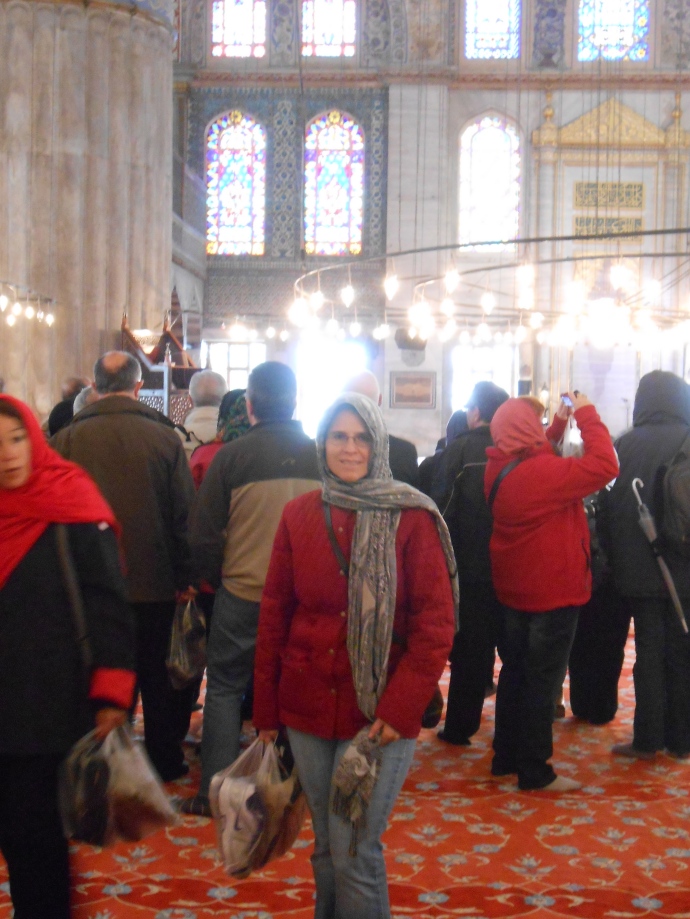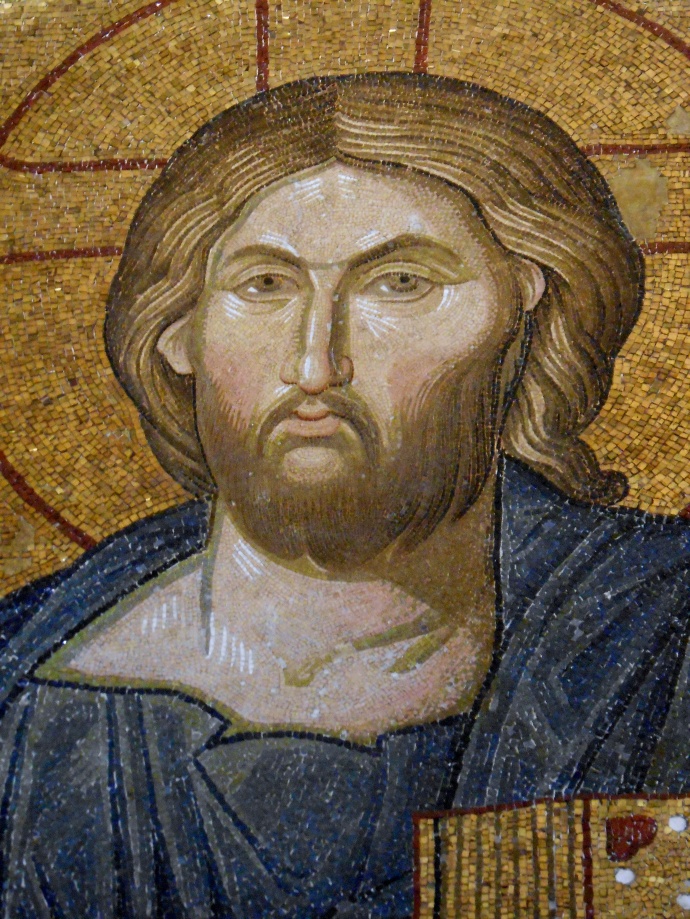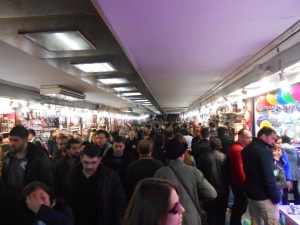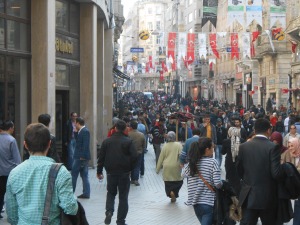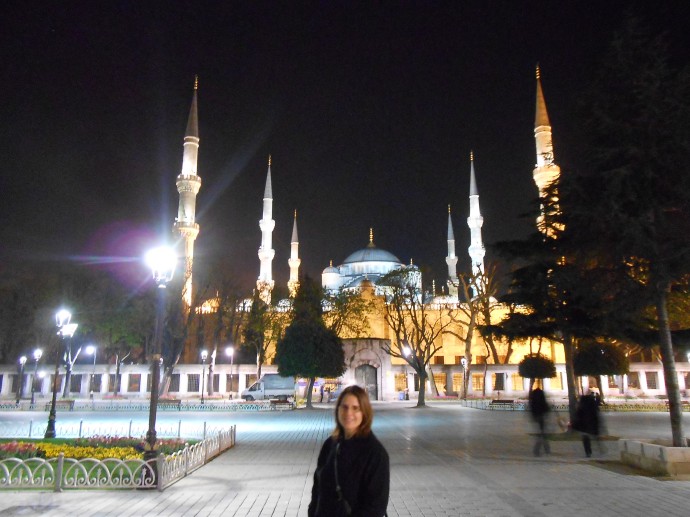Earlier this month Deirdre and I spent four days in Istanbul (f/k/a Constantinople), Turkey. It is an amazing city with fascinating history and culture that combine elements of Europe, Asia, the West, the East, Christianity and Islam. Over the past year or so I have been doing a lot (well, for me anyway) of reading about Rome, the Byzantine Empire and the conflicts between the West and East throughout history. As a result, I really wanted to see Istanbul. Also, visiting Istanbul allowed us to complete our goal of seeing the great old cities of the central and eastern Mediterranean (Rome, Athens, Jerusalem and Istanbul) on this trip.
Istanbul is an enormous city with a population of almost 14 million people. Everywhere we went we were amazed at the crowds in the streets, in the markets and at tourist sights. With that many inhabitants, I guess they have to be somewhere, but we couldn’t get over the constant crush of people. Due to Istanbul’s massive growth since the end of World War II, much of the city is covered by unattractive urban sprawl, and despite its history, blending of cultures and unique location, it surprisingly is not a particularly pretty city. Despite this, tulips may have outnumbered the people in the city. Central Asia is the home of the tulip, and during our trip Istanbul was celebrating its tulip festival so the city was awash in color.
Istanbul sits at the crossroads between Europe and Asia. In fact, the city itself straddles the Bosphorus Strait, the traditional dividing line between Europe and Asia, and it is the only metropolis that covers two continents. Part of Istanbul is in Europe (which contains the Byzantine Empire sights and the major mosques), and part lies in Asia.
Upon arriving at our hotel in the afternoon, we went up to the roof deck to check out the views of the city. Although it was overcast, the huge Blue Mosque towered over the neighborhood where we were staying. That afternoon and evening we toured the Sultanahmet section of the city on foot to get the lay of the land. We walked around and saw the Hagia Sophia and the Blue Mosque from the outside and then headed over to the Grand Bazaar and the Spice Market. The Grand Bazaar is an enormous 15th century version of the shopping mall. It’s a covered shopping center that goes on for blocks and blocks with dozens and dozens of streets containing thousands of shops selling everything you can imagine (with an emphasis on gold and silver jewelry, carpets and spices). The Grand Bazaar almost overwhelms all of your senses with its crowds, sounds, sights and smells. Similarly, the Spice Market contains shops selling pyramid-shaped piles of all imaginable spices.
The next day we made the Hagia Sophia (“Ayasofya” in Turkish) our first stop. The Hagia Sophia is one of the great buildings in the world. Byzantine Emperor Justinian had the Church of the Holy Wisdom constructed in 537 A.D. Although enormous for its time (or any other time), it somehow took only just over five years to build. Until the 16th century, the Hagia Sophia was the largest church in the world.
In 1453, the Ottoman Turks finally succeeded in conquering Constantinople and turned the Hagia Sophia into a mosque. As a result, it now contains both Christian and Islamic symbols. It is said that before entering the Hagia Sophia for the first time after the conquest of Constantinople, Sultan Mehmet II dropped to his knees at the sight of the building. The Hagia Sophia contains an enormous dome, an architectural wonder for its time, and amazing Christian mosaics, many of which are in good shape today as they were revealed again after the building was turned into a museum in 1935.
Our next stop was the also huge Blue Mosque. We learned that the number of minarets or towers a mosque has indicates its significance. The Blue Mosque is one of only two mosques in the world with six minarets, which testifies to its prominent place in Islam. To enter the mosque we were required to remove our shoes and carry them in a bag during our tour. Beautiful “Iznik” tiles cover the interior of the mosque and help give the mosque a blue hue.
After that we headed to the western part of the city to see the Church of the Holy Savior in Chora, a church renowned for its mosaics that are so detailed and precise that many of them look like paintings. Getting there was an adventure. Our guidebook instructed us to take a particular bus, and upon arriving at the large outdoor bus stop near the Grand Bazaar we sought to confirm that we had the right bus information. Doing so without speaking Turkish added some excitement to the effort, but in this case, as in virtually all other interactions while in Istanbul, we found the Turkish people helpful and friendly. In fact, one kid of about 14 who spoke a bit of English made it his job to find and get us on the right bus. Thanks to his help, we wound up on the right bus, one different from our original instructions and one that ended up absolutely packed with people as it made its way through Istanbul. Unfortunately, while we were able to find the right bus, we didn’t have details on the stop we needed to reach the church. After about a half hour jammed on a bus with no one who spoke English, we had decided to jump off and find our way on foot when a man tapped Deirdre on the shoulder and motioned that our stop was coming up. We evidently looked sufficiently out of place that he knew we could have travelled to that neighborhood for only one reason. Seeing the mosaics made the trip worth the hassle.
The following day we spent the morning at the Topkapi Palace, the palace of the sultans for hundreds of years after the conquest of Constantinople. As appears to be the case with all things in Istanbul, the palace was huge and contains treasures that the Ottoman Empire assembled, including an 80-something carat diamond, a relic of St. John the Baptist, the staff of Moses and items that belonged to Mohammed. In addition, we toured the Harem, the living quarters of the sultans and their concubines. Given the size of the palace and its grounds, our tour took up almost half a day.
After that, it was on to the military museum to watch a re-enactment of the military band that preceded the Ottoman armies into battle. The band played a type of music that was designed both to motivate the Ottoman soldiers and to cast fear in the enemy. To my albeit tone-deaf ears, the music certainly seemed appropriate to accomplish both goals. We found it interesting that the hall was packed with Turks, many of whom appeared to be young men of military service age, rather than tourists.
We then headed back to our hotel in the Sultanahment section by walking through Beyoglu, a more modern section of town located across the Golden Horn from the old Byzantine city. We walked down Istiklal Caddesi, a major shopping street so packed with people it’s hard to describe. Curiously, along a maybe two-mile stretch of the street we passed four Starbucks stores. What’s that all about? On the way back we paused to enjoy a cold beer at a restaurant on a bridge overlooking the Golden Horn and watched the sun set behind multiple mosques and minarets.
On the morning of our last day in Istanbul we hopped a ferry over to the Asian side of the city so we could say we planted our feet in Asia and then finished up with a tour of the Basilica Cistern, a surprisingly huge underground cistern used to store water during the Byzantine era.
Istanbul is a unique melding of Western and Eastern, Christian and Muslim histories and cultures. While the sights were impressive, we found experiencing the different culture to be the most memorable part of our visit. Seeing minarets marking mosques all over the city and listening to the rather haunting wail of the call to prayer from the mosques was a noteworthy experience for us. While we found the culture so different from the rest of Europe, we were also cognizant that Turkey, and Istanbul in particular, are the most westernized and secular places in the Middle East and southwest Asia.
Given the different culture we found ourselves in, a small but interesting event occurred in a wine bar where we stopped for a glass of wine. As an aside, although it is a Muslim city, alcohol is generally available throughout Istanbul. In the wine bar we were sitting enjoying a glass of Turkish wine and listening to jazz music on the bar’s sound system. Jazz seemed to be quite popular in Istanbul, and we heard it in a number of locations. We were relaxing, talking and had not been paying much attention to the music when Deirdre and I looked at each other and said together, “Is that “Jingle Bells” playing?” The soundtrack had an acoustic version of “Jingle Bells” which was then followed by “White Christmas.” Listening to “Jingle Bells” and “White Christmas” in April in Istanbul seemed incongruous on at least two levels.
It was readily apparent to us that selling things is a major part of the culture. Istanbul is bursting with shops everywhere you go, and the Grand Bazaar is just the most famous and interesting example of that element of the city’s culture. The entire city itself seemed to be a bazaar, and everywhere we turned someone was trying to sell us something (usually carpets). Carpet store owners would approach us on the street, provide tourist information and then nicely ask us to visit their carpet store. Unlike the folks trying to entice you to buy something in Rome, they were quite witty and funny in their efforts. One guy whom we encountered two days in a row told us on the second day that if we didn’t buy a carpet, when we got to the airport, “The police will ask you where your carpet is and want to know what you were up to in Istanbul if you didn’t buy a carpet.” As interesting and entertaining as it was, it got tiring, and we learned to respond by telling them, “We already bought two carpets. We’re all set.” That seemed to work and allowed us to wander around this unique city taking in its sights, sounds and tastes.
